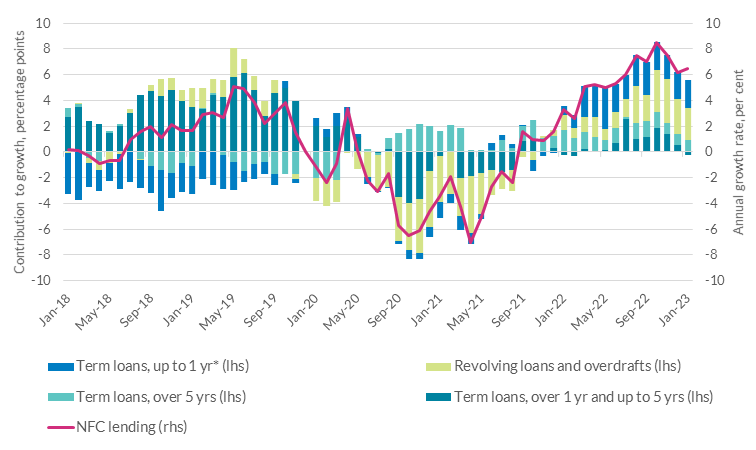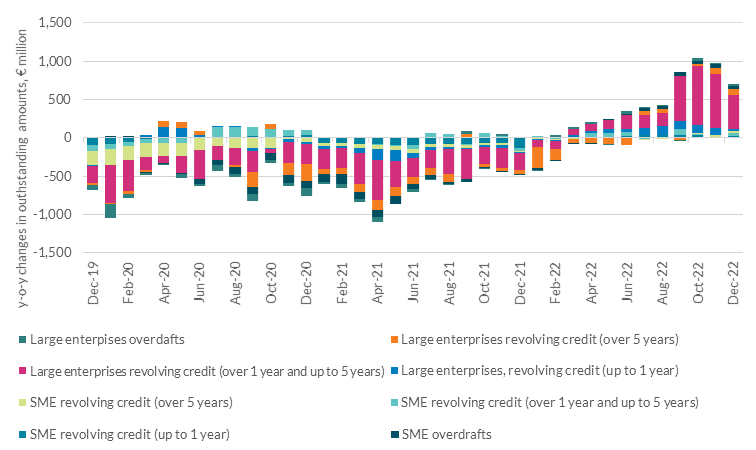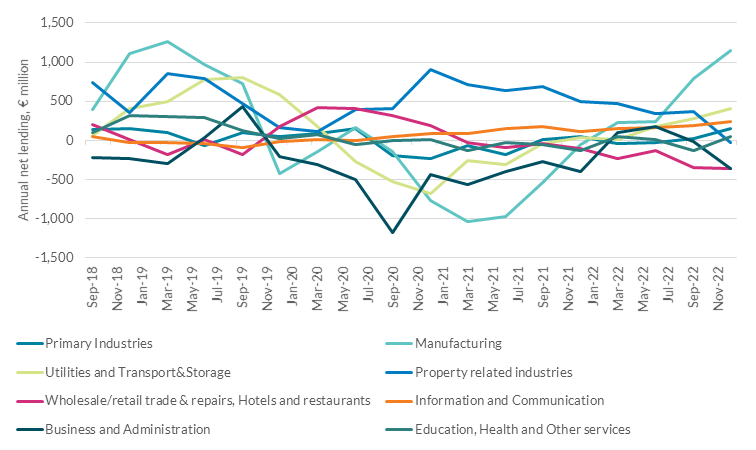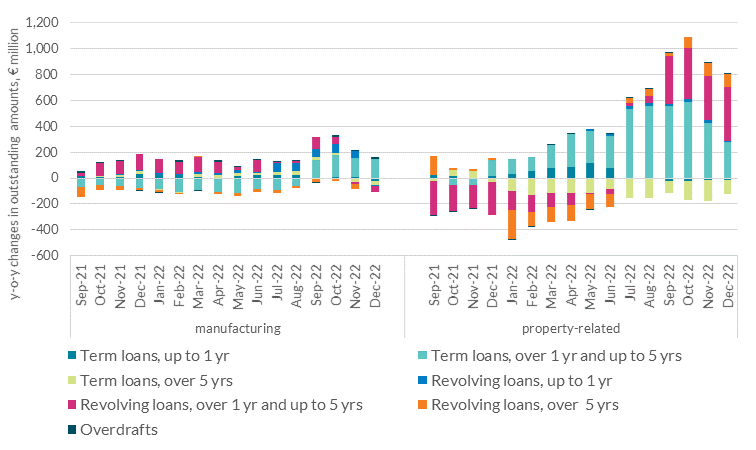Behind the Data

Investigating recent growth in bank lending to non-financial corporations in Ireland
Jack Dempsey, Simone Saupe *
April 2023
Since September 2021, bank lending to Irish non-financial corporations (NFCs) experienced considerable growth. This novel analysis of aggregated and granular level Irish loan data shows that this upward trend was mainly driven by revolving loans drawn down by large enterprises, predominantly in the manufacturing and property-related sectors.
This Behind the Data (BTD) investigates the growth in Irish NFC lending between September 2021 and January 2023. Was this lending concentrated by firm type and/or economic sector? Did firms borrow long-term to finance productive investments or short-term to bridge liquidity shortfalls and finance working capital (Chen et al., 2019)?
By combining aggregated and granular loan data to answer these questions, this BTD provides valuable insights into recent NFC lending trends that help to identify both potential pockets of vulnerabilities in the economy and of risk concentration on banks’ balance sheets. This is particularly important considering the current challenging macroeconomic outlook and tightening global financial conditions that pose challenges on all but in particular short-term borrowers (Central Bank of Ireland Financial Stability Review 2022II, ECB Financial Stability Review, 2022 November). At the same time, credit preferences may tend to shorter maturities at flexible rates in a less accommodative monetary policy environment (see Lane, 2022).
Therefore, the information that this BTD provides on recent trends in the counterpart and maturity structure of loans to NFCs on bank balance sheets can support further Central Bank assessments of the resilience of the Irish economy.
The data
This BTD combines the information on loan instruments, original maturities, enterprise size and economic activity (according to NACE rev.2) available in the aggregated bank balance sheet and SME and large enterprise credit datasets with the details that AnaCredit collects from credit institutions. AnaCredit is a dataset harmonised across the euro area that contains granular information on individual bank loans, including type of credit, outstanding debt, date of origination and contractual maturity, type of interest etc., besides comprehensive debtor information.
AnaCredit covers all loans to legal entities recorded in the aggregated banking statistics. This BTD is one of the first publications in Ireland using this relatively new dataset. It investigates net lending and changes in stocks on bank balance sheets as opposed to new lending. Methodologically, the aggregated data and the AnaCredit data on NFCs used in this BtD are broadly similar. However, it should be noted that the classification by economic activity differs as the aggregated data classifies economic activity in accordance with loan purpose, while the AnaCredit classifies economic activity in accordance with entity type and excludes holding companies. Therefore, AnaCredit will be lower than the aggregated series. Moreover, in the more in-depth analysis of the factors driving the trends in aggregated data, this BTD only takes AnaCredit loans with no missing breakdown details into account and focuses on certain loan instruments.
The analysis concentrates on lending provided to Irish resident enterprises by the domestic banking sector, one important aspect of NFC indebtedness. This can complement work on the role of Irish non-bank lenders (e.g. Heffernan et. al, 2021 on financing SMEs), or on the importance of intra-group lending for the large multinational enterprise (MNEs) presence in Ireland (e.g. Department of Finance, 2019).
Growth mainly driven by revolving loans drawn down by large enterprises
With an average of 4.7 per cent between September 2021 and January 2023, annual growth rates in bank lending to Irish resident NFCs not only recovered from pandemic lows but also returned to sustained levels last seen in early-2009. After its peak in October, with a recorded annual growth rate of 8.5 per cent, the upward trend has slowed down (Chart 1).
Chart 1: Short-term loans, including revolving loans and overdrafts were main drivers of recent trends in net lending to NFC

Source: Central Bank of Ireland, Bank balance sheets. Latest observation January 2023.
Notes: Term loans with original maturity ‘up to 1 year’ adjusted to exclude revolving loans and overdrafts from this maturity bucket.
Chart 1 shows that mainly short-term instruments have driven the recent upward trend, while borrowing with a maturity of “over 5 years” was flat. With €1.9 billion, short-term loans accounted for 89 per cent of total net lending to NFC from September 2021 to January 2023. End-January 2023, the annual growth rate of short-term loans stood at 32 per cent. This compares to an average of minus five per cent over 2018 and 2019. Before the COVID-19 pandemic, growth in NFC lending was concentrated in the “over 1 year and up to 5 years” category.
In accordance with the ECB manual on MFI balance sheet statistics the “up to 1 year” maturity includes “revolving loans and overdrafts” whose total net lending was €1.1 billion during the mentioned period, or 46 per cent of the NFC total. While this treatment reflects that firms may utilise the funds withdrawn within the agreed credit lines to meet short-term financing needs, the actual maturity of overdrafts and in particular revolving loans can exceed one year as the analysis of AnaCredit data indicates.
Analysing only “revolving loans and overdrafts” in the AnaCredit sample, Chart 2 shows that the year-on-year (y-o-y) changes in stocks turned positive in March 2022. End-December 2022, drawdowns exceeded repayments by €709 million regardless of the total agreed credit lines for existing and new contracts on annual basis. Of this, €442 million or 54 per cent of this fell on amounts in the maturity bucket of “over 1 year and up to 5 years” drawn down large enterprises. This stocks in this category increased by 88 per cent in y-o-y terms. AnaCredit which also collects information on the purpose of lending shows an increase of ‘working capital facilities’ for this category in the second half of the year.
Chart 2: Concentration of y-o-y stock increases in ‘revolving credit and overdrafts’ on revolving loans ‘over 1 year and up to 5 years' for large enterprises

Source: Central Bank of Ireland, AnaCredit, Authors’ calculations. Latest observation December 2022.
Note: The sample covers on average over the analysed period 54 per cent of outstanding ‘revolving loans and overdrafts’ to NFC recorded in aggregated balance sheet data. This is largely to the exclusion of holding companies from AnaCredit.
For small and medium enterprises (SME), outstanding revolving loans across all maturities increased by just €87 million during 2022. Overall, total borrowings by SMEs has remained muted (Central Bank of Ireland Financial Stability Review 2022II), with zero growth in Q4 2022.
Large enterprises in manufacturing and property-related sectors were the main drivers of the growth
Looking into net lending to large enterprises by economic activities of large enterprises, Chart 3 shows that throughout 2022 the increases were concentrated on the manufacturing and property-related sectors. The property-related sectors recorded positive annual net lending up to Q3 2022, while for manufacturing the uptake is concentrated on the second half of the year. Other large enterprises, mainly in the utilities, transport and storage sectors recorded considerable increases in net borrowings. In contrast to this, for large firms in the hotel and restaurant sector, repayments exceeded new lending on annual terms.
Chart 3: Net lending to large enterprises positive for majority of non-financial sectors in 2022

Source: Central Bank of Ireland, SME and Large Enterprise Credit and Deposits, Authors’ calculations. Latest observation December 2022.
Information on instrument type and maturity structure of economic sectors’ lending is available in AnaCredit. While overall trends align, the increases of borrowings by large enterprises in manufacturing are less prominent in the analysed sample due to the methodological differences mentioned above.
End-2022, outstanding amounts of loans to large enterprises were concentrated in manufacturing (18 per cent) and in the property-related sectors (32 per cent). In AnaCredit, outstanding amounts in revolving loans for the latter in December 2022 were more than tenfold the outstanding amounts recorded a year earlier. The positive y-o-y stock changes in this category were seen in the second half of the year (Chart 4), accompanied by a shift in the purpose for lending from commercial real estate purchase to working capital facility recorded for this category. Manufacturing has seen positive y-o-y changes in revolving loan stocks up to October, and an uptake in “over 1 year and up to 5 years”term loans in the last quarter of 2022.
Chart 4: Different trends in y-o-y stock changes for term loans and revolving loans withdrawn by large enterprises in manufacturing and property-related sectors

Source: Central Bank of Ireland, Anacredit, Authors’ calculations. Latest observation December 2022.
Notes: The sample covers for manufacturing 30 per cent, and 36 per cent for property-related sectors’ of the stocks recorded for large enterprises in SME and Large Enterprise Credit and Deposits statistics. The AnaCredit figures are lower due to the differing classification of economic activity in AnaCredit and the aggregate data as outlined in the data section. The aggregated figures include all loan types, i.e. also credit card debt, finance leases, trade receivables, other credit lines outside of revolving loans etc..
For both sectors, the share of revolving loans “over 1 year and up to 5 years” in the total outstanding loans reported by banks has increased by around five percentage points when comparing December 2022 figures to pre-pandemic levels of December 2019. For other sectors, particularly “other service activities”, “wholesale and retail” and SMEs in general stocks in “over 1 year and up to 5 year” term loans have declined over 2022. For all large enterprises in the analysed sample long-term loans lost relative importance. This reflects tendencies to increased short-term borrowings by large enterprises observed in the Bank Lending Survey.
Conclusion
This novel analysis of aggregated and granular Irish loan data shows that the increase in NFC lending between September 2021 and January 2023 was concentrated in revolving loan amounts withdrawn by large enterprises, predominantly in the manufacturing and property-related sectors. This is a valuable insight to support further assessment of Irish firm resilience as revolving loans are typically utilised to fund working capital needs and continue operations as evidence in AnaCredit indicates. Albeit allocated to “up to 1 year” in the aggregated loan data, these loans might not necessarily expire within a year but still expose borrowers to rollover risks. This should be taken into account when analysing aggregated loans figures. Studies on the use of revolving loans and other loan instruments with short-term characteristics would complement this analysis.
Furthermore, the BTD finds a shift to short-term credit during the period, in which uncertainty is elevated and monetary policies are tightened (see Sherman and Woods, 2023 for credit demand perspective). It also confirms that the uptake in Irish bank lending to domestic NFC in recent months was driven by large enterprises, while SME lending was flat.
*Email [email protected] if you have any comments or questions on this note. Comments from Jean Cassidy, Mary Cussen, Tiernan Heffernan, Robert Kelly, Vasileios Madouros, Jenny Osborne-Kinch and Maria Woods are gratefully acknowledged. The views expressed in this note are those of the authors and do not necessarily reflect the views of the Central Bank of Ireland or the ESCB.
See also: